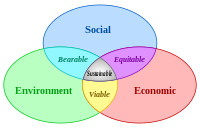
Photo from wikipedia
The high performance of alloy materials can be maintained with compositional “plainification” The hardening of copper by alloying with tin and lead in the Early Bronze Age (∼4000 BCE) is… Click to show full abstract
The high performance of alloy materials can be maintained with compositional “plainification” The hardening of copper by alloying with tin and lead in the Early Bronze Age (∼4000 BCE) is one of the earliest recorded examples of improving material performance by tailoring composition. Today, many high-performance applications, from jet engines to computer chips, use alloys that may contain almost any element in the periodic table. However, increasing the number of components in alloyed materials makes their production and recycling more difficult and comes at the risk of resource exhaustion of scarce or rare-to-source elements. The associated increase in material costs may lead to only modest property enhancements. The sustainability of alloying-based strategies is part of a general problem for many materials systems (1). Substantial efforts have focused on reducing alloying, especially substituting toxic and rare-to-source elements in materials, as exampled by initiatives such as the Element Strategy Initiative in Japan, started in 2008, and the “plainification of materials” in China, effective in 2018.
Journal Title: Science
Year Published: 2019
Link to full text (if available)
Share on Social Media: Sign Up to like & get
recommendations!